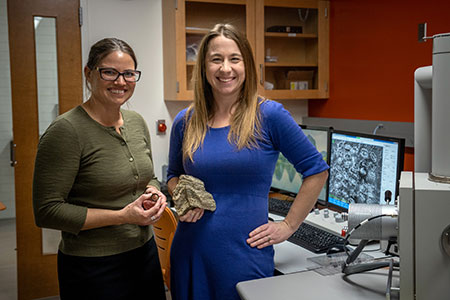WSU honors top faculty for contributions to campus, community
OGDEN, Utah – On Dec. 5, Weber State University announced the recipients of two prestigious faculty awards: the John S. Hinckley Fellow Award and Exemplary Collaboration Award.
John S. Hinckley Fellow Award
Art professor Matthew Choberka was selected as the 2022 Hinckley fellow for excellence in teaching, scholarship and community engagement.
Choberka has inspired art students at Weber State since 2005.
He serves as director of the Matthew S. Browning Center for Design, a collaborative space focused on urban arts design and planning, and co-teaches a study abroad program in Venice, Italy, for art and art history students. Previously, he served as chair of WSU’s Department of Visual Art and Design.
“Matt is a superstar scholar and his talent has been widely recognized,” said WSU provost Ravi Krovi. “Many of his students have gone on to attend the best graduate programs in the nation.”
Choberka’s art has been showcased nationally and internationally, including two solo exhibits in Beaux-Arts des Ameriques in Montreal, Canada. Three of his recent paintings were featured in issue 150 of the New American Paintings journal.
“Weber State is the kind of place where ambitions, and even daydreams, are rewarded,” Choberka said. “Whether I served as department chair or had the privilege of taking students to Venice, Italy, I’ve been able to keep up my research and find that balance between my studio practice and teaching.”
Off campus, Choberka was instrumental in planning and implementing the Dumke Arts Plaza, a public space in downtown Ogden dedicated to art exhibits and performances.
Exemplary Collaboration Award
Kristin Rabosky, associate professor of physics, and Elizabeth Balgord, associate professor of earth and environmental sciences, led a three-year project spanning across physical science programs to receive Weber State’s Exemplary Collaboration Award.
The team’s project involves faculty and students collecting and analyzing zircon-bearing rock samples using electron microscopy and mineral separation techniques. The results will be used to piece together the geologic history of northern Utah.
Although the work takes place in shared labs at WSU’s Tracy Hall Science Center, the findings could benefit organizations across Utah and the surrounding states.
“Students have taken part in every part of this process,” Balgord said.
Undergraduate students in earth and environmental sciences collected, processed and ran samples to determine the age of the rocks, while physics students developed protocols for imaging the grains and processing those images, gathering information on the composition of various zones within the zircons.
“It’s been an eye-opening experience to see students in the sciences talking to each other in a way that you don’t normally see at the undergraduate level,” Rabosky said. “It’s been fun to see our students grow through this project, and we’re excited to see where this takes us over the next few years.”
The project has resulted in the submission of a significant National Science Foundation grant proposal that would secure new equipment and allow the team to expand collaboration with regional institutions and other organizations across the nation.
Bryan Magaña, public relations director
801-626-7948, bryanmagana@weber.edu- Contact:
Bryan Magaña, public relations director
801-626-7948, bryanmagana@weber.edu